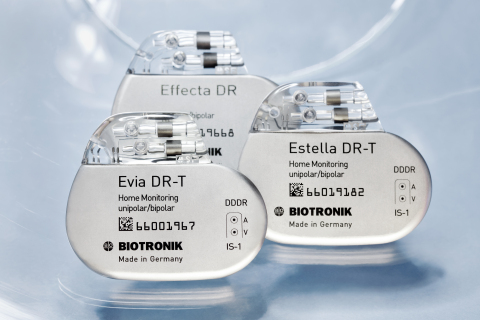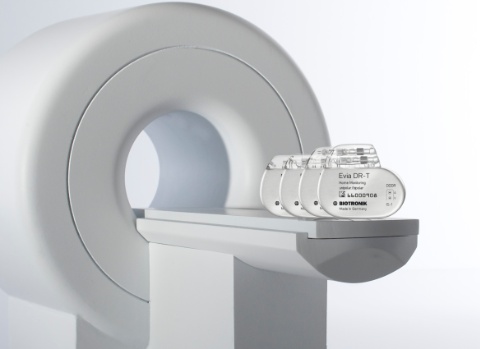Lower percent of right ventricular pacing (%VP) correlates with less risk of heart failure (HF) hospitalization, mortality and atrial fibrillation (AF)
BERLIN--(BUSINESS WIRE)--BIOTRONIK, a leading manufacturer of implantable cardiac devices and pioneer of wireless remote monitoring technologies, today announced the print publication of "Reduction of Right Ventricular Pacing with Advanced Atrioventricular Search Hysteresis: Results of the PREVENT Study", by Christof Kolb, M.D., et al, on behalf of the PREVENT study group (doi: 10.1111/j.1540-8159.2011.03075.x) in Pacing and Clinical Electrophysiology (PACE).1
The potential reduction of unnecessary right ventricular pacing (%VP) has been an important debate in today's cardiac pacemaker therapy as it is directly correlated with the incidence of comorbidities and associated risks. Over time, chronic ventricular pacing causes ventricular dysfunction and is associated with an increased risk of HF hospitalizations and death.2 Furthermore, it has been shown that minimizing the ventricular pacing percentage results in a 40% reduced relative risk of AF, which is an independent predictor of stroke and mortality.3,4,5
PREVENT was a prospective, randomized, international, crossover study enrolling 202 patients with a goal to evaluate whether an enhanced atrioventricular search hysteresis (AVSH) with a longer search interval has an increased benefit in terms of %VP reduction over standard AVSH in patients with a class I pacemaker indication.
The enhanced AVSH technology from BIOTRONIK, called the Intrinsic Rhythm Support (IRSplus) algorithm, incorporates two different functions: the first is scan hysteresis, which better enables the heart to pace on its own by periodically extending the search time for its natural pacing stimulus (the intrinsic AV conduction) over six consecutive atrial cycles. The second is the repetitive hysteresis, which recognizes when the heart is not pacing on its own (a consistent loss of intrinsic AV conduction lasting for six consecutive atrial cycles) and switches the mode of the device from extended to basic atrioventricular (AV) delay.
Of all patients 47% had a history of intermittent AV block, which is a sporadic inability of the heart to conduct signals from the atrium into the ventricle. Especially in those patients, the enhanced AVSH decreased the median %VP to only 21% compared to 26% with standard AVSH. The overall percentage of ventricular pacing of only 4% (versus 5.5% in patients with standard AVSH) represents the potential for further improvement in the reduction of side-effects due to %VP.
The study investigators initially state that, "Until now, no other study has evaluated the potential incremental benefit of repetitive hysteresis and scan hysteresis in terms of %VP reduction. Our study shows that the additional use of repetitive hysteresis and scan hysteresis on top of the conventional AVSH parameters offers further %VP reduction."
"The PREVENT study has proven that the IRSplus enhanced AVSH algorithm provides physicians with a straightforward solution for programming BIOTRONIK pacemakers to reduce unnecessary right ventricular pacing-a capability that is so important in minimizing the risk of heart failure hospitalization, mortality, and atrial fibrillation," commented Marlou Janssen, Vice President of Global Marketing and Sales, BIOTRONIK. "BIOTRONIK is investing to become a leader in providing clinical evidence and the publication of the PREVENT study is another milestone in realizing this commitment to the medical community."
About BIOTRONIK SE & Co. KG
As one of the world's leading manufacturers of cardiovascular medical devices, with several million devices implanted, BIOTRONIK is represented in over 100 countries by its global workforce of over 5,600 employees. Known for having its finger on the pulse of the medical community, BIOTRONIK assesses the challenges physicians face, and provides the best solutions for all phases of patient care, ranging from diagnosis to treatment to patient management. Quality, innovation and reliability define BIOTRONIK and its growing success, and deliver confidence and peace of mind to physicians and their patients worldwide.
More information: www.biotronik.com
2 Sweeney et al.; Heart Failure during Cardiac Pacing; Circulation, 2006; 113: 2082-2088.
3 Sweeney et al; Minimizing ventricular pacing to reduce AF in SND; N Engl J Med 2007; 357:100-8.
Upon publication, please provide us with a copy.
Photos/Multimedia Gallery Available: http://www.businesswire.com/cgi-bin/mmg.cgi?eid=6847540&lang=en
Contacts
BIOTRONIK SE & Co. KG
Sandy Hathaway
Senior Director, Global Communications
Tel. +49 (0) 30 68905 1602
Email: sandy.hathaway@biotronik.com

Evia, Estella and Effecta: BIOTRONIK Pacemakers (Photo: Business Wire)
Evia ProMRI Pacemaker (Photo: Business Wire)




